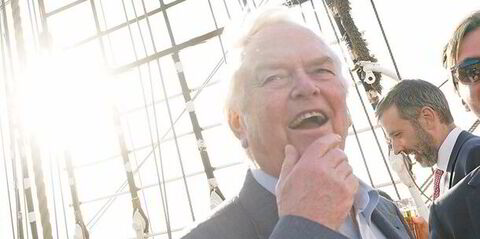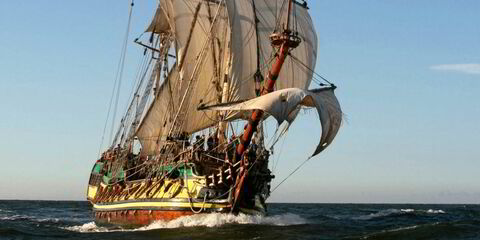Financing a fleet the size of that controlled by Greek owners in today’s financial-market circumstances poses an interesting challenge.
Data from various sources suggests that in 2013 a total of $20bn went into financing Greek owners for newbuildings and, to a smaller extent, secondhand purchases. With both yard prices and asset values perceived to have bottomed out, activity has heated up from early this year. Although it is too soon to compile firm totals of spending, Greeks appear to have splashed out over $3bn on secondhand tonnage in the first four months of the year, while, with a rash of orders that broke out in April, some have already set newbuilding commitments as high as $4bn.
So where is all this money coming from?
Petrofin Bank Research, which has been publishing comparative data on traditional bank finance to Greek shipping for the past 13 years, found that in 2013 banks had a total exposure to Greek owners of $61.5bn, down 6.15% from the previous year. There were fewer banks lending — 46 compared to 51 in 2012 — and lending by Greek banks had fallen to its lowest level ever, with just five banks amassing a total portfolio of $10.5bn.
Far Eastern financial institutions that had been expected to take up some of the slack have, in fact, not increased their total portfolio significantly. According to Petrofin’s data, six Far Eastern banks are active in lending to Greek owners, with an aggregate portfolio in 2013 of $3.7bn, representing just over 6% of total lending.
The top lender remained Royal Bank of Scotland (RBS), with a total portfolio of $8.8bn, but like several others, the amount of its committed but undrawn funds has decreased, indicating less finance for newbuildings. In February, RBS revealed a sharp increase in shipping impairment losses for 2013, with provisions totalling £341m ($567.28m) last year from £82m in 2012 — not a happy indicator given that the 81% state-owned bank has been looking at major restructuring.
Western bank lending has been strangled by ever increasing regulatory pressure and problems involving their existing portfolios, while banks that found themselves in trouble saw their management being handed over to bureaucrats.
“The risk-management people took over from the business people, so the power of the business people was lost within the bank structure and you got paralysis through analysis,” said George Syllantavos, co-chief executive and chief financial officer of Nautilus Shareholdings and a long-time money man.
“In a world of doubt, to banks profitability came second to financial strength. As the majority of shipping banks were European [72% of global ship finance in December 2013], the difficulty of European banks had a pronounced effect on Greek ship lending,” agreed Petrofin’s Ted Petropoulos.
Almost everyone concurs that with asset values at almost historical lows, the time was perfect for banks to restart their ship lending.
“They were lending 80% of vessel value at Libor [London interbank offered rate] plus 0.8% on a capesize worth $120m. It’s a pity they are not able to lend 60% of vessel value at Libor plus 3.75% on the same vessel now worth $50m. You have more margin on the loan and less exposure on the steel,” Syllantavos said.
So, where is the money coming from? The answer lies in inventiveness and ingenuity on many levels, and in many different places, including the over-the-counter (OTC) market, initial public offerings (IPOs) and private equity. The latter continues to play an important role, with some well-publicised link-ups, such as that between Costamare and York Capital, and many more partnerships said to be flying below the radar (see private equity story, page 66).
To return for a moment to the banking scene, there are some who have spotted the current opportunities. Last year, a group of investors, including Henning Oldendorff of Germany, Arne Blystad of Norway and former Torm boss Klaus Kjaerulff of Denmark decided to launch a new Oslo-based bank. Maritime & Merchant Bank (M&M) will offer finance to small and medium-size players and, according to managing director Halvor Sveen, it is expected to build up a lending portfolio of around $3.3bn within five years. Board member Dagfinn Lunde, former head of shipping with DVB Bank, tells TradeWinds that Greeks are very much on the radar, both as investors in the bank and potential clients.
While on the subject of Oslo, the OTC market there has attracted a number of shipping companies in recent months, as they look to use it as a jumping off point for a full New York listing.
Dorian LPG is a typical example of this. Trading on the Oslo OTC, the company is looking to launch its IPO in the Big Apple. However, between early March and the end of April, Dorian had already slashed its target from $287.5m to $142.4m.
Five shipping-related IPOs took place in the US last year and analysts were expecting more in 2014, as private-equity investors look for an exit from their involvements. It appears, however, that there has been some cooling of ardour and in April, Stalwart Tankers pulled a planned $186m offering after it would have to price well below its target range.
As of April, there was also speculation on whether a planned $100m fund-raiser by Quintana Shipping would go ahead, while widespread reports of an impending IPO by Oceanbulk and its private-equity partner, Oaktree Capital Management, have not yet been verified.
Many more are known or believed to be waiting in the wings for the right time, including Super-Eco Tankers, an outfit that has been set up by the Tomasos family, Atlas Maritime and Pyxis Maritime.
Unquestionably, Greek owners were among the earliest players to see the opportunities of raising money from the public markets, with Tsakos Energy Navigation (TEN) this year celebrating 13 years on the New York Stock Exchange (NYSE), having also started out its public life in Oslo. The rush to float came after 2005 and since close to 30 Greek-led companies have listed. Not all have made it but more than half the US-listed oceangoing shipping companies are Greek and they have succeeded in raising billions of dollars through all types of instruments.



